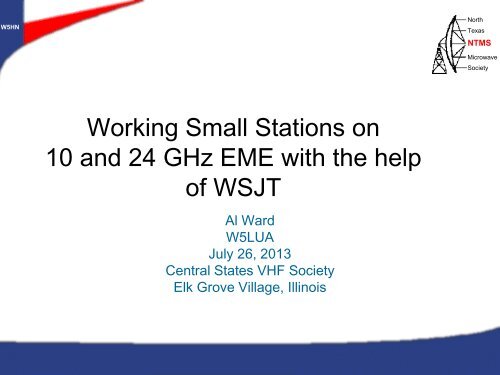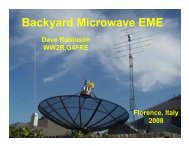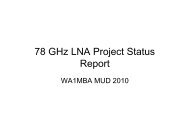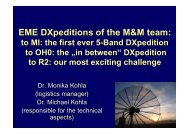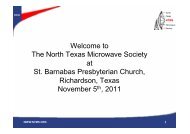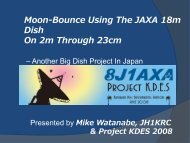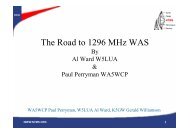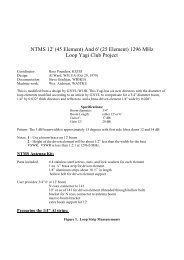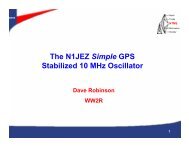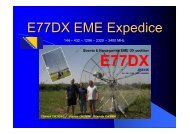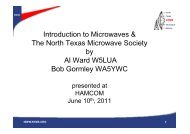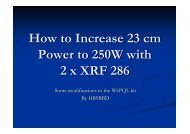Create successful ePaper yourself
Turn your PDF publications into a flip-book with our unique Google optimized e-Paper software.
W5HN<br />
North<br />
Texas<br />
<strong>NTMS</strong><br />
Microwave<br />
Society<br />
Working Small Stations on<br />
<strong>10</strong> and <strong>24</strong> <strong>GHz</strong> <strong>EME</strong> with the help<br />
of <strong>WSJT</strong><br />
Al Ward<br />
<strong>W5LUA</strong><br />
July 26, 2013<br />
Central States VHF Society<br />
Elk Grove Village, Illinois
W5HN<br />
The Microwave Bands<br />
North<br />
Texas<br />
<strong>NTMS</strong><br />
Microwave<br />
Society<br />
Band Frequency Range Weak signal work in NA<br />
33 cm 902 to 928 MHz 902 MHz (Region II only NA & SA)<br />
23 cm 1<strong>24</strong>0 to 1300 MHz 1296 MHz<br />
13 cm 2300 to 23<strong>10</strong> MHz 2304 MHz (2301 VK, 2320 some Europe<br />
and VE – cross band required<br />
2390 to <strong>24</strong>50 MHz <strong>24</strong><strong>24</strong> JA<br />
9 cm 3300 to 3500 MHz 3456 MHz (3400 MHz used for <strong>EME</strong>)<br />
6 cm 5650 to 5925 MHz 5760 MHz<br />
3 cm <strong>10</strong>000 to <strong>10</strong>500 MHz <strong>10</strong>368 MHz (<strong>10</strong>450 MHz used by JA)<br />
1.25cm <strong>24</strong>000 to <strong>24</strong>250 MHz <strong>24</strong>192 MHz (<strong>24</strong>048 MHz used for <strong>EME</strong>)<br />
.6 cm 47000 to 47200 MHz 47088 MHz<br />
.35 cm 77000 to 8<strong>10</strong>00 MHz 78192 MHz (77184 MHz used by<br />
RW3BP, <strong>W5LUA</strong>, & VE4MA)<br />
The problem…Not all countries have same allocation as us……..
W5HN<br />
How long have hams been doing<br />
<strong>EME</strong> on the upper bands<br />
North<br />
Texas<br />
<strong>NTMS</strong><br />
Microwave<br />
Society<br />
• First 902 MHz <strong>EME</strong> QSO on January 22, 1988 between K5JL and WA5ETV<br />
• First 1296 MHz <strong>EME</strong> QSO in 1960 between W1BU and W6HB<br />
• First 2304 MHz <strong>EME</strong> QSO in 1970 between W4HHK and W3GKP<br />
• First 3456 MHz <strong>EME</strong> QSO on April 7, 1987 between W7CNK and KD5RO<br />
• First 5760 MHz <strong>EME</strong> QSO on April <strong>24</strong>, 1987 between W7CNK and WA5TNY<br />
• First <strong>10</strong>368 MHz <strong>EME</strong> QSO on August 27, 1988 between WA7CJO and<br />
WA5VJB<br />
• First <strong>24</strong>192 MHz <strong>EME</strong> QSO on August 18, 2000 between <strong>W5LUA</strong> and<br />
VE4MA<br />
• First 47088 MHz <strong>EME</strong> QSO in January 2005 between RW3BP and AD6FP<br />
followed by <strong>W5LUA</strong> and RW3BP<br />
• First 77184 MHz <strong>EME</strong> QSO TBD – RW3BP has heard echoes and was<br />
copied by <strong>W5LUA</strong> in June 2013, VE4MA also working towards <strong>EME</strong>.
W5HN<br />
JT-65 for <strong>EME</strong><br />
• Joe Taylor’s (K1JT) <strong>WSJT</strong> digital modes have certainly<br />
revolutionized weak signal, meteor, and <strong>EME</strong> communications<br />
• JT-65A used on 6M<br />
• JT-65B used on 2M through 70 cm<br />
• JT-65C used on 1296 MHz through 5760 MHz – Struggle at 5760<br />
MHz due to excessive doppler shift during 1 minute transmission –<br />
Hand always on knob!<br />
• Using JT-65C on <strong>10</strong> <strong>GHz</strong> and higher a struggle due to doppler shift<br />
being more than 200 Hz per minute!<br />
• Additional challenge is that on <strong>10</strong> <strong>GHz</strong> and higher, the libration<br />
spreading can be as large as several hundred Hz which is much<br />
more than the <strong>10</strong>.8 Hz tone spacing of JT65C – Signals sound<br />
aurora like<br />
North<br />
Texas<br />
<strong>NTMS</strong><br />
Microwave<br />
Society<br />
WWW.<strong>NTMS</strong>.ORG 4
W5HN<br />
JT-4 Mode<br />
North<br />
Texas<br />
<strong>NTMS</strong><br />
Microwave<br />
Society<br />
• The JT-4 mode uses 4 tones and offers a<br />
range of tone spacings up to 315 Hz.<br />
• JT-4F was found to be optimum for <strong>10</strong> and<br />
<strong>24</strong> <strong>GHz</strong> based on normal spreading of the<br />
signal.<br />
• Only disadvantage of JT-4F is that there<br />
is no sync pulse as power is divided<br />
equally among the 4 tones.<br />
WWW.<strong>NTMS</strong>.ORG 5
W5HN<br />
Bandwidth Comparison between<br />
JT4 Modes and JT-65C<br />
North<br />
Texas<br />
<strong>NTMS</strong><br />
Microwave<br />
Society<br />
Mode<br />
Expansion Factor<br />
N<br />
Tone Spacing<br />
(Hz)<br />
Bandwidth<br />
(Hz)<br />
JT4A 1 4.375 17.5<br />
JT4B 2 8.75 35<br />
JT4C 4 17.5 70<br />
JT4D 8 39.375 158<br />
JT4E 18 78.75 315<br />
JT4F 36 157.5 630<br />
JT4G 72 315.0 1260<br />
JT-65C<br />
<strong>10</strong>.8 Hz<br />
711 Hz<br />
When libration spreading is low, contacts on <strong>10</strong> <strong>GHz</strong> are possible with<br />
JT-65C but our success rate went up with the JT-4 modes especially<br />
at <strong>24</strong> <strong>GHz</strong> where the spreading shows less peaking than seen at <strong>10</strong><br />
<strong>GHz</strong>. Narrower antenna beamwidths also help to reduce the effective<br />
spreading of signals<br />
WWW.<strong>NTMS</strong>.ORG 6
W5HN<br />
Keeping on Frequency<br />
North<br />
Texas<br />
<strong>NTMS</strong><br />
Microwave<br />
Society<br />
• The <strong>WSJT</strong> waterfall only has a several kHz wide passband.<br />
• How do we keep our continuously doppler shifted signal within the pass<br />
band Doppler can be as high as 25 kHz at moon rise on <strong>10</strong> <strong>GHz</strong><br />
• Answer…we must continuously correct our receive frequency to<br />
compensate for the mutual doppler between us and the station we are trying<br />
to work.<br />
• Initially VK7MO was doing all the frequency correction at his end for both<br />
receive and transmit so all I had to do was set my Flex5000 to the sked<br />
frequency<br />
• Recently K5GW wrote similar code for the Flex5000 to control both my<br />
receive and transmit frequencies so as to put my transmitted frequency<br />
precisely on the schedule frequency at any observer on earth by just<br />
knowing their 6 digit grid square.<br />
• GPS frequency locking is a requirement for the microwave LO.<br />
WWW.<strong>NTMS</strong>.ORG 7
W5HN<br />
Picking the best times<br />
North<br />
Texas<br />
<strong>NTMS</strong><br />
Microwave<br />
Society<br />
• Perigee (when the moon is closest to earth) is<br />
always best<br />
• Need to pick times when spreading is lowest so<br />
that the tones can fall into the narrow spaced<br />
frequency bins required for both JT-65C and JT-4<br />
• I use an <strong>EME</strong> tracking program by K5GW that<br />
predicts times of lowest libration spreading – other<br />
programs by VK3UM and F1EHN<br />
WWW.<strong>NTMS</strong>.ORG 8
W5HN<br />
5M and 2.4M Dishes at <strong>W5LUA</strong><br />
Used on 432 MHz through <strong>10</strong> <strong>GHz</strong> Used on <strong>24</strong>, 47 and 77 <strong>GHz</strong><br />
North<br />
Texas<br />
<strong>NTMS</strong><br />
Microwave<br />
Society<br />
WWW.<strong>NTMS</strong>.ORG 9
W5HN<br />
VK7MO .7M Prime Focus Dish<br />
used on <strong>10</strong> <strong>GHz</strong> <strong>EME</strong><br />
North<br />
Texas<br />
<strong>NTMS</strong><br />
Microwave<br />
Society<br />
3dB Beamwidth<br />
=2.5 degrees<br />
DB6NT Power<br />
amplifier 45 watts<br />
@ the feed<br />
NF 1 dB<br />
WWW.<strong>NTMS</strong>.ORG <strong>10</strong>
W5HN<br />
VK7MO uses rifle scope for<br />
tracking<br />
North<br />
Texas<br />
<strong>NTMS</strong><br />
Microwave<br />
Society<br />
WWW.<strong>NTMS</strong>.ORG 11
W5HN<br />
VK7MO-<strong>W5LUA</strong> OCT 18<br />
23:01Z<br />
North<br />
Texas<br />
<strong>NTMS</strong><br />
Microwave<br />
Society
W5HN<br />
VK7MO portable in OF89ai<br />
North<br />
Texas<br />
<strong>NTMS</strong><br />
Microwave<br />
Society
W5HN<br />
VK7MO Receiving <strong>W5LUA</strong> in<br />
Grid Square PF06 on <strong>10</strong> <strong>GHz</strong><br />
North<br />
Texas<br />
<strong>NTMS</strong><br />
Microwave<br />
Society<br />
WWW.<strong>NTMS</strong>.ORG 14
W5HN<br />
VK7MO working <strong>W5LUA</strong> from motel<br />
room on <strong>10</strong> <strong>GHz</strong> <strong>EME</strong> from<br />
Grid Square PF58kn<br />
North<br />
Texas<br />
<strong>NTMS</strong><br />
Microwave<br />
Society<br />
WWW.<strong>NTMS</strong>.ORG 15
W5HN<br />
Using JT-4G on <strong>10</strong> <strong>GHz</strong><br />
North<br />
Texas<br />
<strong>NTMS</strong><br />
Microwave<br />
Society<br />
Working some issues with DT numbers that appear to be 1 to<br />
2 seconds high compared to actual path delay prediction
W5HN<br />
QSO Procedure using JT-4F/G<br />
North<br />
Texas<br />
<strong>NTMS</strong><br />
Microwave<br />
Society<br />
• Both stations send 1270 Hz to help with alignment –<br />
usually for about 5 minutes<br />
• Both calls are sent<br />
• When both calls are received then send both calls and<br />
dB signal report as calculated by <strong>WSJT</strong><br />
• When both calls and report are received then send<br />
single tone @1500 Hz which designates R<br />
• When R is received , then send single tone @1700 Hz<br />
which designates 73<br />
• When signals are strong then text can be substituted for<br />
single tones<br />
WWW.<strong>NTMS</strong>.ORG 17
W5HN<br />
1.14M Prime Focus Dish used<br />
by VK7MO on <strong>24</strong> <strong>GHz</strong> <strong>EME</strong><br />
North<br />
Texas<br />
<strong>NTMS</strong><br />
Microwave<br />
Society<br />
AZ-EL Mount Details<br />
WWW.<strong>NTMS</strong>.ORG 18
W5HN<br />
<strong>24</strong> <strong>GHz</strong> QSO with VK7MO<br />
using JT-4F<br />
North<br />
Texas<br />
<strong>NTMS</strong><br />
Microwave<br />
Society<br />
K5GW software controls Flex 5000 frequency
W5HN<br />
VK7MO Seeing his Echoes on <strong>24</strong> <strong>GHz</strong><br />
North<br />
Texas<br />
<strong>NTMS</strong><br />
Microwave<br />
Society<br />
WWW.<strong>NTMS</strong>.ORG 20
W5HN<br />
North<br />
Texas<br />
<strong>NTMS</strong><br />
Microwave<br />
Society<br />
<strong>24</strong> <strong>GHz</strong> <strong>EME</strong> QSO Between <strong>W5LUA</strong><br />
and OZ1FF<br />
March 2013
W5HN<br />
OZ1FF on <strong>24</strong> <strong>GHz</strong> – 1270 Hz<br />
North<br />
Texas<br />
<strong>NTMS</strong><br />
Microwave<br />
Society
W5HN<br />
OZ1FF on <strong>24</strong> <strong>GHz</strong> – 1270 Hz<br />
North<br />
Texas<br />
<strong>NTMS</strong><br />
Microwave<br />
Society
W5HN<br />
OZ1FF on <strong>24</strong> <strong>GHz</strong><br />
sending messages<br />
North<br />
Texas<br />
<strong>NTMS</strong><br />
Microwave<br />
Society
W5HN<br />
Calls Received<br />
North<br />
Texas<br />
<strong>NTMS</strong><br />
Microwave<br />
Society
W5HN<br />
Receiving single tone R from<br />
OZ1FF<br />
North<br />
Texas<br />
<strong>NTMS</strong><br />
Microwave<br />
Society
W5HN<br />
Receiving 73 from OZ1FF<br />
North<br />
Texas<br />
<strong>NTMS</strong><br />
Microwave<br />
Society
W5HN<br />
<strong>24</strong> <strong>GHz</strong> Stations using JT-4<br />
North<br />
Texas<br />
<strong>NTMS</strong><br />
Microwave<br />
Society<br />
• VK7MO .7 M Prime focus dish and 9 watts<br />
• <strong>W5LUA</strong> 2.4M Offset fed dish and <strong>10</strong>0 watts<br />
• OK1KIR 4.5M Prime focus dish and 20 watts<br />
• VK3XPD 3M Prime focus dish and 15 watts<br />
• OZ1FF 1.8M Offset fed dish and <strong>10</strong> watts<br />
Other stations QRV on <strong>24</strong> <strong>GHz</strong> <strong>EME</strong> via CW include VE4MA, RW3BP,<br />
OK1UWA, LX1DB, G4NNS, DK7LJ, DF1OI, PA0EHG, DL7YC, IK2RTI,<br />
JA6CZD, F2CT, RK3WWF<br />
WWW.<strong>NTMS</strong>.ORG 28
W5HN<br />
Coordination<br />
• HB9Q Logger for schedule coordination and chat on 432<br />
MHz and higher http://hb9q.ch/version2/index.php<br />
• 432 MHz and Above newsletter published every month<br />
for over 30 years<br />
http://www.nitehawk.com/rasmit/em70cm.html<br />
• Moon-Net Reflector http://www.nlsa.com/nets/moon-nethelp.html<br />
• Moon Reflector http://lists.moonbounce.info/cgibin/mailman/listinfo/moon<br />
• Microwave Reflector http://lists.valinet.com/cgibin/mailman/listinfo/microwave<br />
North<br />
Texas<br />
<strong>NTMS</strong><br />
Microwave<br />
Society<br />
WWW.<strong>NTMS</strong>.ORG 29
W5HN<br />
You might very well be close<br />
with your tropo setup but..<br />
North<br />
Texas<br />
<strong>NTMS</strong><br />
Microwave<br />
Society<br />
• Are you GPS locked<br />
• Do you have the proper software for predicting the moon location<br />
• Can you track the moon Remember a 36 inch dish has a 3dB<br />
beam width of 2.3 degrees and a 1 dB beam width of 1.3 degrees at<br />
<strong>10</strong> <strong>GHz</strong><br />
• Elevation is easy – Remote a Sears inclinometer as written up by<br />
WA8RJF<br />
• Azimuth – Use either a US Digital absolute encoder or an<br />
incremental encoder and a W2DRZ system or an HB9DRI system<br />
for both az and el. Other option for US Digital absolute encoders is<br />
the use of a Weeder RS-232 controlled relay control board and<br />
K5GW software<br />
• Calibration – use the sun<br />
• Let’s run!<br />
WWW.<strong>NTMS</strong>.ORG 30
W5HN<br />
Thanks to K1JT & VK7MO<br />
North<br />
Texas<br />
<strong>NTMS</strong><br />
Microwave<br />
Society<br />
• Thanks to Joe Taylor K1JT for taking<br />
inputs and comments from VK7MO to help<br />
optimize the JT-4 modes for <strong>10</strong> and <strong>24</strong><br />
<strong>GHz</strong> <strong>EME</strong><br />
• Check out Dubus 2/2013 for the article<br />
“Small Station <strong>EME</strong> at <strong>10</strong> & <strong>24</strong> <strong>GHz</strong> by<br />
Rex Moncur, VK7MO, and Joe Taylor,<br />
K1JT<br />
WWW.<strong>NTMS</strong>.ORG 31
W5HN<br />
<strong>EME</strong> has been conquered through 47 <strong>GHz</strong><br />
Next Challenge – 77<strong>GHz</strong> <strong>EME</strong><br />
North<br />
Texas<br />
<strong>NTMS</strong><br />
Microwave<br />
Society<br />
WWW.<strong>NTMS</strong>.ORG 32
W5HN<br />
Reception of RW3BP by <strong>W5LUA</strong> on 77184 MHz<br />
on June 12, 2013 using RW3BP’s MMCW Program<br />
North<br />
Texas<br />
<strong>NTMS</strong><br />
Microwave<br />
Society<br />
WWW.<strong>NTMS</strong>.ORG<br />
.wav file as replayed by RW3BP<br />
Same .wav file as replayed by<br />
<strong>W5LUA</strong> with 497 ppm correction to<br />
message length<br />
33
W5HN<br />
<strong>W5LUA</strong> 77 <strong>GHz</strong> Assembly at<br />
Feed of 2.4 M Dish<br />
North<br />
Texas<br />
<strong>NTMS</strong><br />
Microwave<br />
Society<br />
WWW.<strong>NTMS</strong>.ORG 34
W5HN<br />
77 <strong>GHz</strong> Power Needed!<br />
North<br />
Texas<br />
<strong>NTMS</strong><br />
Microwave<br />
Society<br />
• Power needed – any leads on available<br />
power in the 77 to 81 <strong>GHz</strong> frequency<br />
range appreciated! My 47 <strong>GHz</strong> TWT is<br />
providing about 13 dB gain at 77 <strong>GHz</strong> but<br />
not sure of the power capability, also<br />
tuning is very touchy!<br />
WWW.<strong>NTMS</strong>.ORG 35
W5HN<br />
Thanks for Listening!<br />
North<br />
Texas<br />
<strong>NTMS</strong><br />
Microwave<br />
Society<br />
• Any Questions<br />
• My presentation will be posted to<br />
www.ntms.org after the conference<br />
WWW.<strong>NTMS</strong>.ORG 36


